CCNA – RIP Questions
Here you will find answers to RIP Questions
Note: If you are not sure about RIP, please read my RIP tutorial.
Question 1
Which statement about RIPng is true?
A. RIPng allows for routes with up to 30 hops.
B. RIPng is enabled on each interface separately.
C. RIPng uses broadcasts to exchange routes.
D. There can be only one RIPng process per router.
Answer: B
Explanation
RIPng is similar to RIPv2 but is used for IPv6. But unlike RIPv1 and RIPv2, RIPng is enabled on each interface separately. For example:
Router(config)#ipv6 unicast-routing (Enables the forwarding of IPv6 unicast datagrams globally on the router)
Router(config)#interface fa0/0
Router(config-if)#ipv6 rip 9tut enable (9tut is the process name of this RIPng)
Question 2
What are two characteristics of RIPv2? (Choose two)
A. classful routing protocol
B. variable-length subnet masks
C. broadcast addressing
D. manual route summarization
E. uses SPF algorithm to compute path
Answer: B D
Question 3
Refer to the exhibit. Which (config-router) command will allow the network represented on the interface to be advertised by RIP?
| router rip version 2 no auto summary ! interface ethernet0 ip address 10.12.6.1 255.255.0.0 |
A. redistribute ethernet0
B. network ethernet0
C. redistribute 10.12.0.0
D. network 10.12.0.0
Answer: D
Question 4
Refer to the exhibit. What information can be gathered from the output?
| RouterA#debug ip rip RIP protocol debugging is on00:34:32: RIP: sending v2 flash update to 224.0.0.9 via FastEthernet8/0 (172.16.1.1) 00:34:32: RIP: build flash update entries 00:34:32: 10.10.1.0/24 via 0.0.0.6, metric 1, tag 0 00:34:32: RIP: sending v2 flash update to 224.0.0.9 via Loopback (10.10.1.1) 00:34:32: RIP: build flash update entries 00:34:32: 10.0.0.0/8 via 0.6.0.0, metric 2, tag 0 00:34:32: 172.16.1.0/24 via 0.0.0.0, metric 1, tag 0 00:34:32: RIP: ignored v2 packet from 16.10.1.1 (sourced from one of our addresses) 06:34:33: RIP: received v2 update from 172.16.1.2 on FastEthernet0/6 66:34:33: 16.6.0.0/8 via 6.0.6.6 in 1 hops 66:34:44: RIP: sending v2 update to 224.6.6.9 via FastEthernet0/0 (172.16.1.1) 66:34:44: RIP: build update entries 66:34:44: 10.10.1.0/24 via 0.0.0.0, metric 1, tag 0 |
A. One router is running RIPv1.
B. RIP neighbor is 224.0.0.9.
C. The network contains a loop.
D. Network 10.10.1.0 is reachable.
Answer: D
Question 5
Which series of commands will configure router R1 for LAN-to-LAN communication with router R2? The enterprise network address is 192.1.1.0/24 and the routing protocol in use is RIP. (Choose three)
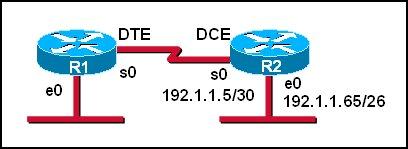
A.
R1 (config)# interface ethernet 0
R1 (config-if)# ip address 192.1.1.129 255.255.255.192
R1 (config-if)# no shutdown
B.
R1 (config)# interface ethernet 0
R1(config-if)#ip address 192.1.1.97 255.255.255.192
R1 (config-if)# no shutdown
C.
R1 (config)# interface serial 0
R1 (config-if)# ip address 192.1.1.4 255.255.255.252
R1 (config-if)# clock rate 56000
D.
R1 (config)# interface serial 0
R1(config-if)#ip address 192.1.1.6 255.255.255.252
R1 (config-it)# no shutdown
E.
R1 (config)# router rip
R1 (config-router)# network 192.1.1.4
R1 (config-router)# network 192.1.1.128
F.
R1 (config)# router rip
R1 (config-router)# version 2
R1 (config-router)# network 192.1.1.0
Answer: A D F
Explanation
First we notice that the ip address of the E0 interface of R2 is 192.1.1.65/26, which has:
+ Increment: 64 (/26 = 1111 1111.1111 1111.1111 1111.1100 0000)
+ Network address: 192.1.1.64
+ Broadcast address: 192.1.1.127
Therefore, the ip address of the E0 interface of R1 cannot belong to this range or the network cannot operate correctly.
In answer A, the ip address of E0 interface of R1 is 192.1.1.129, which does not belong in this range -> A is correct.
In answer B, E0 interface of R1 has the ip address of 192.1.1.97, which belongs in this range -> B is not correct.
The s0 interface of R1 must belong to the same network of s0 interface of R2, which has:
+ Increment: 4 (/30 = 1111 1111.1111 1111.1111 1111.1111 1100)
+ Network address: 192.1.1.4
+ Broadcast address: 192.1.1.7
The ip 192.1.1.5 has been used by s0 of R2 so the only suitable ip address of s0 of R1 is 192.1.1.6 -> C is wrong but D is correct.
Now the last thing we must do is enabling RIP. Because e0 interface of R1 and e0 interface of R2 have the same major network (192.1.1.0/24) so we must use RIP version 2 to support discontiguous network -> F is correct.
For answer E, if we configure 2 networks
R1 (config-router)# network 192.1.1.4
R1 (config-router)# network 192.1.1.128
then these networks will be automatically summarized as 192.1.1.0 network.
Question 6
Refer to the exhibit. Two routers have just been configured by a new technician. All interfaces are up. However, the routers are not sharing their routing tables. What is the problem?

A. Split horizon is preventing Router2 from receiving routing information from Router1.
B. Router1 is configured for RIP version 2, and Router2 is configured for RIP version 1.
C. Router1 has an ACL that is blocking RIP version 2.
D. There is a physical connectivity problem between Router1 and Router2.
E. Router1 is using authentication and Router2 is not.
Answer: B
Explanation
As we can see from the output, Router2 is sending v1 update and ignoring v2 update from neighbor so we can conclude Router2 is running RIPv1. Its neighbor, Router1 (ip address of 192.168.2.1), is running RIPv2.
Notice that router running RIPv2 can “understand” RIPv1 update but router running RIPv1 cannot understand RIPv2 update.
Question 7
What is the default routing update period for RIPv2?
A. 15 seconds
B. 30 Seconds
C. 180 Seconds
D. 240 Seconds
Answer: B
Question 8
Refer to the exhibit. The network manager is evaluating the efficiency of the current network design. RIPv2 is enabled on all Layer 3 devices in the network. What network devices participate in passing traffic from the PC at 10.10.1.7 to File Server at 10.20.1.6 in the order that they will forward traffic from source to destination?
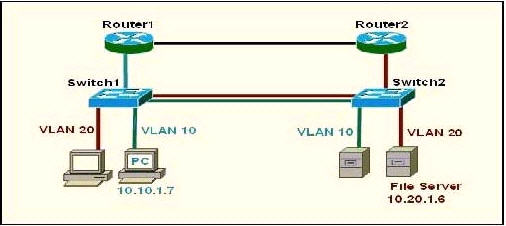
A. Switch, Switch2
B. Switch, Switch2, Router2, Switch2
C. Switch1, Router1, Switch1, Switch2
D. Switch1, Router1, Router2, Switch2
Answer: D
Explanation
The PC and File Server are in different VLANs so surely traffic from PC to File Server must go through Router1 but which path will the packet go next, through Router 2 or Switch1? Well, it is a hard question to answer.
As many comments said “the connection between R1 and Switch is Blue, so that means its under Vlan 10, and R2 to Switch 2 is red. The two routers do not have subinterfaces and are not running router on a stick basing on the color of the links” so D should be the correct answer.
Just for your information, I keep this explanation (which supports answer C) but in the exam you should choose D as your answer!
I haven’t had tested it yet but I guess that because there is a VLAN 20 on Switch 1 so Router1 will try to send that packet back to Switch1. If the link between Switch1 and Switch2 is a trunk link then the returned packet will also be sent to this link. Switch 2 receives that packet and it sends to the File Server at VLAN20. So the path will be Switch1 -> Router1 -> Switch1 -> Switch2.
There are some debates about this question but if the routers are properly configured then the packets can go from Switch1 -> Router1 -> Router2 -> Switch2 (D answer) so D can be a correct answer.
Question 9
Refer to the exhibit. Router A has interfaces with addresses 192.168.1.1 and 172.16.1.1. Router B, which is connected to router A over a serial link, has interfaces with address 172.16.1.2 and 10.1.1.2.
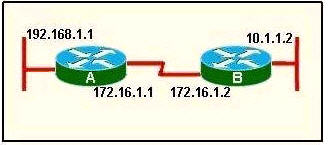
Which sequence of commands will configure RIPv2 on router B?
A.
B( config)# router rip
B(config-router)#version 2
B(config-router)# network 172.16.0.0
B(config-router)# network 10.0.0.0
B(config-router)# end
B.
B(config)# router rip 2
B(config-router)# network 172.16.0.0
B(config-router)# network 10.0.0.0
B(config-router)# end
C.
B(config)# router rip
B(config-router)#version 2
B(config-router)# network 172.16.0.0
B(config-router)#network 192.168.1.0
B(config-router)#end
D.
B(config)# router rip version 2
B(config-router)# network 172.16.0.0
B(config-router)# network 10.0.0.0
B(config-router)#end
Answer: A
Question 10
Refer to the exhibit. S0/0 on R1 is configured as a multipoint interface to communicate with R2 and R3 in this hub-and-spoke Frame Relay topology.
While testing this configuration, a technician notes that pings are successful from hosts on the 172.16.1.0/24 network to hosts on both the 172.16.2.0/25 and 172.16.2.128/25 networks. However, pings between hosts on the 172.16.2.0/25 and 172.16.2.128/25 networks are not successful. What could explain this connectivity problem?
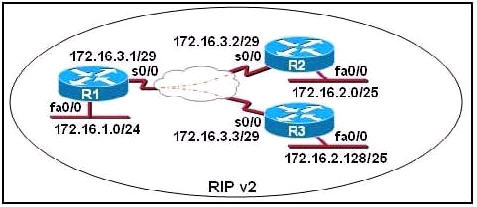
A. The ip subnet-zero command has been issued on the R1 router.
B. The RIP v2 dynamic routing protocol cannot be used across a Frame Relay network.
C. Split horizon is preventing R2 from learning about the R3 networks and R3 from learning about the R2 networks.
D. The 172.16.2.0/25 and 172.16.2.128/25 networks are overlapping networks that can be seen by R1, but not between R2 and R3.
E. The 172.16.3.0/29 network used on the Frame Relay links is creating a discontiguous network between the R2 and R3 router subnetworks.
Answer: C
Explanation
The “ip subnet-zero” allows the use of the first subnet but it doesn’t cause this problem and we don’t have that first subnet (like 172.16.0.0/24) so we can’t confirm if the “ip subnet-zero” was used or not -> A is not correct.
Frame-Relay can use RIPv2 with no problem if we configure it correctly -> B is not correct.
In the exhibit above we notice that the s0/0 interface of R1 has not been divided into sub-interfaces so the split horizon will prevent updates from R2 to R3 and vice versa. The split horizon rule states “A router never sends information about a route back in same direction which is original information came”. In this case R2 send an update to S0/0 of R1 so R1 cannot send that update back on S0/0 -> R3 will not learn about networks of R2 (and vice versa) -> C is correct.
172.16.2.0/25 and 172.16.2.128/25 networks are not overlapping networks. They are two different sub-networks -> D is not correct.
RIPv2 is a classless routing protocol so it supports VLSM and discontiguous networks -> E is not correct.
Question 11
Refer to the exhibit. After a RIP route is marked invalid on Router_1, how much time will elapse before that route is removed from the routing table?
| Router_1# show ip protocols Routing Protocol is “rip” Sending updates every 30 seconds, next due in 8 seconds Invalid after 180 seconds, hold down 180, flushed after 240 Outgoing update filter list foe all interfaces is not set Incoming update filter list for all interfaces is not set Router 1# |
A. 30 seconds
B. 60 seconds
C. 90 seconds
D. 180 seconds
E. 240 seconds
Answer: B
Explanation
The question reads: After a RIP route marked invalid on Router_1, how much time will elasped before that route is removed from the routing table.
The word “REMOVED” in the question means “FLUSHED”
Carefully look at the Router_1 show ip protocol output:
Invalid is 180 secs.
Flushed is 240secs.
RIP route marked invalid (180secs.)
Time elasped before route is removed (Flushed 240secs.)
The difference is 60secs……..240-180=60. Actually is 180+60=240.
Please notice that the invalid timer, hold down timer and flush timer start counting at the same time.
Question 12
Refer to the graphic. Host 1 cannot receive packets from Host 2. Assuming that RIP v1 is the routing protocol in use, what is wrong with the IP configuration information shown? (Choose two)
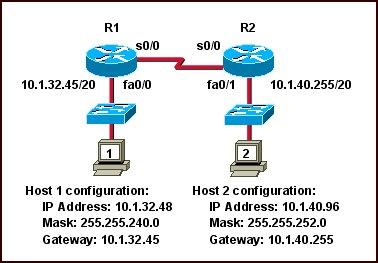
A. The fa0/1 interface of router R2 has been assigned a broadcast address.
B. The fa0/1 network on router R2 overlaps with the LAN attached to R1.
C. Host 2 has been assigned the incorrect subnet mask.
D. Host 1 has been configured with the 255.255.248.0 subnet mask.
E. Host 2 on router R2 is on a different subnet than its gateway.
Answer: B C
Explanation
The fa0/1 interface of R2 is assigned an IP address of 10.1.40.255/20. It seems to be a broadcast address but it is not. If we calculate the range of this network we will understand why:
Network 10.1.40.255/20
Increment: 16 (/20 = 1111 1111.1111 1111.1111 0000.0000 0000)
Network address: 10.1.32.0
Broadcast address: 10.1.47.255
-> 10.1.40.255/20 is an usable host address -> A is not correct.
The IP address of host 1 (10.1.32.48) belongs to the range of interface fa0/1 on R2 as shown above -> B is correct.
In the topology above, all subnet masks are /20 (255.255.240.0) excepting the subnet mask of Host 2 (255.255.252.0) so C can be incorrect.
The subnet mask of Host 1 is 255.255.240.0, not 255.255.248.0 -> D is not correct.
Host 2 is not on a different subnet than its gateway even if the subnet mask 255.255.252.0 is used. Let’s analyze the range of Host 2 network:
Network 10.1.40.96/22
Increment: 4
Network address: 10.1.40.0
Broadcast address: 10.1.43.255
Its gateway (10.1.40.255) is still belongs to this range -> E is not correct.
Note: In this question, C is the best suitable answer after eliminating A, D, E answers. But in fact Host 2 can ping its gateway because they are on the same subnet.
Question 13
What two things will a router do when running a distance vector routing protocol? (Choose two)
A. Send periodic updates regardless of topology changes.
B. Send entire routing table to all routers in the routing domain.
C. Use the shortest-path algorithm to the determine best path.
D. Update the routing table based on updates from their neighbors.
E. Maintain the topology of the entire network in its database.
Answer: A D
Question 14
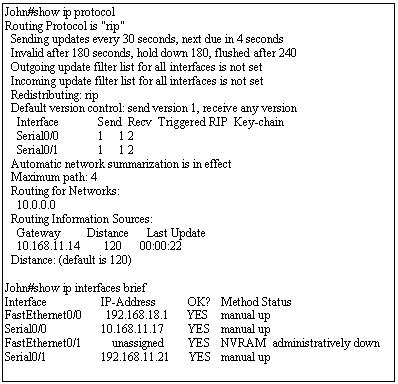
Use the output from the router shown in the graphic above to determine which of the following are correct. (Choose two)
A. Router John uses a link-state routing protocol.
B. Router John will receive routing updates on the Serial0/0 interface.
C. Router John will receive routing updates on the Serial0/1 interface.
D. Router John will send routing updates out the Serial0/0 interface.
E. Router John will send routing updates out the FastEthernet0/0 interface.
F. Router John will send routing updates out the Serial0/1 interface.
Answer: B D
Explanation
As you can see under “Routing for networks”, network “10.0.0.0″ is advertising. The IP address of S0/0 is 10.168.11.17 which belongs to 10.0.0.0 network -> RIP is running on s0/0 interface only, not s0/1 -> S0/0 will send and receive RIP updates.
Question 15
What can be determined from the line of show ip route output shown in the exhibit? (Choose two)
R 10.10.10.8 [120/2] via 10.10.10.6,00:00:25, Serial0/1
A. The next routing update can be expected in 35 seconds.
B. The IP address 10.10.10.6 is configured on S0/1.
C. The IP address 10.10.10.8 is configured on S0/1.
D. This route is using the default administrative distance.
E. The 10.10.10.8 network is two hops away from this router.
Answer: D E
Explanation
From the output, we can see 2 parameters [120/2]. The first is the administrative distance of the routing protocol being used. In this case it is RIP (symbolized by the letter “R”). Because 120 is also the default administrative distance value of RIP -> D is correct.
In RIP, the metric is hop count so “2″ means the network 10.10.10.8 is two hops (routers) away from this router.



Hello guys, Iam currently studying for my ccna using chris bryant ccent 1 videos,they are quite awesome the problem is i dont have ccent 2 videos,if you have cant you email them to me?rebamodimooagile@mascom.bw
@9tut
in Q 13
B is also right bz in distance vector (RIP) send entire routing table to all routers in routing domain in every 30 sec.
thn y answer A and D ?
@kushal arora: RIP only sends entire routing table to all directly connected routers, not to “all routers in routing domain”.
@9tut ..thnx ;) …got it now !
can some one explain Q14 for me pls. because understand RIP has split horizone as part of its feature where routing update can not be sent and receive on the same interface. why B and D??????????????
@ 9tut or someone else!! in question 12 , HOW DO WE FIND THE Broadcast address: 192.1.1.127?? IN A EASY WAY WHEN WE HAVE THE NETWORK ID, please respond!!! regards,
what is the correct answer for this i thought it was E
Router_1# show ip protocols
Routing Protocol is “rip”
Sending updates every 30 seconds, next due in 8 seconds
Invalid after 180 seconds, hold down 180, flushed after 240
Outgoing update filter list foe all interfaces is not set
Incoming update filter list for all interfaces is not set
Router 1#
A. 30 seconds
B. 60 seconds
C. 90 seconds
D. 180 seconds
E. 240 seconds
hi, i need help in Q5
It is stated that the ip address of the E0 interface of R1 cannot belong to this range or the network cannot operate correctly.I dont understand why .Can some1 pls explain.Thanks in advance
hi , is jerico’s dump questions still available ?Heard cisco was going to change the ccna questions.Can someone clear this .
sorry still valid *
@Anonymous
It’s just saying that in the 192.1.1.0 network, R2′s LAN takes the ip’s 192.1.1.64 (the network address) through 192.1.1.127 (the broadcast address). That means that R1′s LAN can’t include any of those ip addresses or else you would end up with one ip assigned to two devices (which makes it hard to send packets to the correct device). Answer B tries to set R1′s LAN interface to 192.1.1.97, which is within that range, so B is wrong.
Guys.. could u help me with Q4. Which line of the “debug ip rip” answered for (D) Network 10.10.1.0 is reachable. appreciate the assistant, thanks.
guyss.. also with Q14, which statements that I should look for.. I’m a bit confuse regarding this question also.. :( appreciate the asst. thanks in advance..
ok.. already found the answer for Q4.. “66:34:44: 10.10.1.0/24 via 0.0.0.0, metric 1, tag 0″ huhu. :D
To clarify Q11, I quote from the book “IP Routing Primer” by Cisco Press:
“The flush timer and the invalid timer run concurrently”
“The holddown timer, which is 180 seconds for RIP, starts when the invalid timer expires.”
Which means,
t=0s: Flush timer and Invalid timer start
t=180s: Invalid timer expires, holddown timer starts
t=240s: Flush timer expires
Hence 9tut’s answer (60s) is correct.
I consider this an official explanation by Cisco book, hope it’ll clear all doubts.
That takes a long period of time to get more information referring to this good post on http://www.9tut.com but the paper writing service can support everyone to select the proper pre written essay or to buy essay. Good luck!
that right
Hi all, In CCNA exam if there are 2 options to be selected as answers, if 1 answer is right and other is wrong, will i get half the mark alloted for that question?
@Satz I would like to know that to!
@all
q5 needs more clarity for correct answer F. In my opinoin:
-Not discontiguous networks
-The network command will include both interfaces
-The ethernet network is then advertised with VLSM to R2
can some one explain Q14 for me pls. because understand RIP has split horizone as part of its feature where routing update can not be sent and receive on the same interface. why B and D??????????????
Guys regarding question 13
EIGRP is a distance vector routing protocol right?But if I am not mistaken it does not send periodic updates regardless topology changes.I am wrong?Why is A correct?
Q5 R2 E0 is using address 192.1.1.65/26 which make the network 192.1.1.64-128. Answer B 192.1.1.97/26 overlaps with this network making it ineligible to use. So you have to use 192.1.1.129/26. which is network 192.1.1.128-192. And Ripv1 doesn’t support VLSM either so you have to use Ripv2
@Jima Q14 If you look at the output your only routing for network 10.0.0.0 and serial0/0 10.168.11.14 is the only interface with a 10.0.0.0 address. And serial0/0 is sending v1 updates and receiving v1 and v2 updates. Serial0/1 192.168.11.21 is not being routed so no updates will be sent or received on that interface.
@Bob Hi. Actually I am asking for help about Q. 13. I think you might have confused me with someone’s else question (?).
Thank you anyway.
Q14. Help. I understand what Bob said about se0/0. I don’t see why C is not correct too.
Can’t Se0/1 receive updates even though it may not be sending out network information?
Isn’t that what is ment in the Show ip protocol under:
Interface Send Recv
Serial 0/0 1 1 2
Serial 0/1 1 1 2
Answer should be BCD ?
Assuming that the entire network topology is shown, what is the operational status of interfaces status of interfaces R2 indicated by the command out put shown?
Question here: http://www.aiotestking.com/cisco/2012/04/what-is-the-operational-status-of-the-interfaces-of-r2-as-indicated-by-the-command-output-shown/
Please say the correct answer as so many places I have seen wrong ans. as i learned the course
@jima
9tut “@kushal arora: RIP only sends entire routing table to all directly connected routers, not to “all routers in routing domain”.
Always Check The Previous Comments.
@Jamshed
C.The Interfaces Are Functioning Correctly.
Bcuz oF The Interfaces r Status: UP – Protocol: UP
@Cold
QUESTION 13
EIGRP is a distance vector routing protocol right? But if I am not mistaken it does not send periodic updates regardless topology changes. I am wrong?Why is A correct?
actually eigrp is a hybrid protocol… that means it is the combination of distance vector protocol and link state protocol….
if you read the latest cisco press and the official books from cisco, EIGRP is considered officially as a distance vector routing protocol by Cisco. They have used to call it hybrid in the past. I believe this question is outdated and might be confusing for some people.
@jima
EIGRP is an ADVANCED distance victor Protocol
The Only Example For Distance Victor Routing iS RIP.
Option A. Send periodic updates regardless of topology changes.
RIP send Updates after every 30 sec (Periodic updates).
@9tut
Regarding Q4.
“66:34:44: RIP: sending v2 update to 224.6.6.9 via FastEthernet0/0 (172.16.1.1) ”
I think above multicast address should be 224.0.0.9
Anyone please assist…with Q11….keeping the following source from cisco in mind…
flush
Flush timer: Amount of time (in seconds) that must pass before the route is removed from the routing table. The interval is measured from the last update received for the route. The interval should be longer than the larger of the invalid and holddown values. If the interval is less than the sum of the update and holddown values, the proper holddown interval cannot elapse, which results in a new route being accepted before the holddown interval expires. The default is 240 seconds.
Got it thanks…240-180 = 60!
Can anyone explain me Q.14.. i did’t get the answer…
@akkii
Bob September 30th, 2012
@Jima Q14 If you look at the output your only routing for network 10.0.0.0 and serial0/0 10.168.11.14 is the only interface with a 10.0.0.0 address. And serial0/0 is sending v1 updates and receiving v1 and v2 updates. Serial0/1 192.168.11.21 is not being routed so no updates will be sent or received on that interface.
PLZ CHECK Previous Comments Before Posting
Q4 what does “via 0.0.0.0″ mean on the debug ip rip command? I’ve seen it on other questions too.. Also, what does tag 0 mean?
little bit complicated…
please explain me que no. 5 !! i am confused between answer E & F. please answer in detail!
explain que 14 also!
I’ll give CCNA exam in first week of November..
please contact me who recently passed CCNA exam or planning to give CCNA exam…
please tell me which dump is good and sims…
er.anita.annu@gmail.com
Regards for sharing the information with us on http://www.9tut.com. good luck
@JAINAL,
A is not correct because on the of output says: routing protocol is RIP
B is correct because where it says routing for networks is the 10.0.0.0 network, the same classful network for the serial 0/0
C is not correct because the serial0/1 has the IP 192.168.11.21 and it is not included on the routing for network statement.
D is correct, same answer as B
routing information sources is the IP: 10.168.11.14 10.168.11.17 as it says on the “show ip int brief” command on the serial 0/0
E and F are not correct because as you can see, those interfaces are not participating in the RIP propagation updates because only appears the 10.0.0.0 network.
So just check out the routing for network which means I will use only the network 10.0.0.0 and from there, you can reference which interfaces are running this protocol.
I think this is my correct explanation, but it someone has a better feedback, I will appreciate it, and I hope this is is help to you
@9tut and all
Question 11
Refer to the exhibit. After a RIP route is marked invalid on Router_1, how much time will elapse before that route is removed from the routing table?
Router_1# show ip protocols
Routing Protocol is “rip”
Sending updates every 30 seconds, next due in 8 seconds
Invalid after 180 seconds, hold down 180, flushed after 240
Outgoing update filter list foe all interfaces is not set
Incoming update filter list for all interfaces is not set
Router 1#
A. 30 seconds
B. 60 seconds
C. 90 seconds
D. 180 seconds
E. 240 seconds
Answer: B
———————————————————————————–
how come answer is B because it clearly says flushed after 240…so answer should be 240 sec not 60 sec…
please explain if i am wrong thanks
question 6:
What I have learned from the book is V1 will send V1 update but can accept both 1 and 2.V2 can send and rx only V2.
But the above explanation is totally different.
can someone clarify this for me
Even in Q14 ,refer to the output of sh ip protocols ,it shows rip vesion 1 is sending 1 and can accept both 1 and 2
Asif the invalid, holddown and flushed timers all start at the same time. The updates keep happening every 30. If it the updates do not show the interface backup after the holddown timer expires the invalid timer which is the same time as the holddown marks the route invalid. So 180 seconds are already gone. After 240 seconds the flush timer which has been running at the same time expires and the route is flushed so 280 – 180 = 60 seconds. the question clearly states after the route is marked invalid.
asif I meant 240-180=60
I am not sure about Q.13:
What two things will a router do when running a distance vector routing protocol? (Choose two)
A. Send periodic updates regardless of topology changes.
B. Send entire routing table to all routers in the routing domain.
C. Use the shortest-path algorithm to the determine best path.
D. Update the routing table based on updates from their neighbors.
E. Maintain the topology of the entire network in its database.
Can’t be the answers A and B?